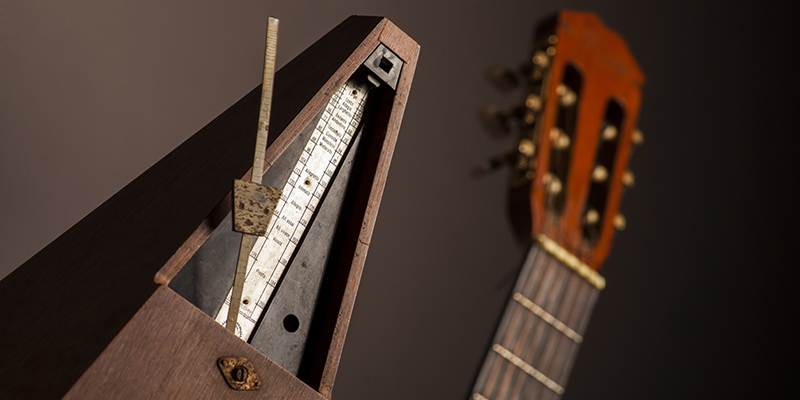It's Time to Use a Metronome
 When it comes to being an excellent musician, practice makes perfect and timing is everything. Although practicing with a metronome can seem like a chore, we can assure you that if used correctly the metronome can act as an accompaniment partner and help improve your playing.
When it comes to being an excellent musician, practice makes perfect and timing is everything. Although practicing with a metronome can seem like a chore, we can assure you that if used correctly the metronome can act as an accompaniment partner and help improve your playing.
Slow it Down
The most important and effective metronome tip that we can pass down would be to start out slow. When you start to view the metronome as a new component to your practice, you will naturally find yourself wanting to match the tempo of the song that you are attempting to play. This is not great use of a metronome, especially if you are a beginner. A good rule of thumb to building a strong rhythm, while executing each note with precision, is to start out at a much slower tempo and gradually build you way up to full speed. It is through this type of discipline that will help reinforce the foundation for having a solid technique as well as keeping good time.
Mute the Beat
One technique that has proven to be very effective when practicing with a metronome is to mute specific beats to strengthen your playing. For example, by muting the down beat you will be forced to focus on your timing and to execute your notes during that silent beat. If your timing is off when the beat returns, this is a clear indication that you need to evaluate your timing and technique i.e you need to slow down the tempo or pay better attention during that missing beat.
Once mastered, this concept can be applied even further to the muting of entire bars or transitioning between playing one bar with sound and one bar muted. If this is your first time trying this technique, you may notice that your timing is way off when the sounded bar comes back into play. Don’t be alarmed, this happens to every player when trying this for the first time. Our advice is to not be discouraged, but to look at this is major potential to grow and a musician!
This is similar to how a vocalist will sing a passage of a song with no accompaniment and when they are finished, check that their pitch has not wavered by playing a note on the piano. If they notice that their pitch has shifted they will adjust up or down.
Offbeats
Consider this tip an appendage of “Mute the Beat”. Just like how you can use a metronome to play downbeats, you can also use it as a tool to play upbeats as well. Although more difficult for some, playing on the upbeat can be a very useful technique to strengthening and improving one's time.
This tip has proven to be particularly useful for musicians practicing jazz. Assigning the metronome to only play the back-beat (i.e beats 2 and 4 in a bar of 4/4 time) can help improve a musician's improvisational technique while keeping solid time. The goal of using a metronome in this manner is to shake up the tedium of that constant click, while establishing room for creative space and productivity.
The Vanishing Click or “Burying the Click”
This isn't so much of a tip as it is a milestone in your career while playing with a metronome. The whole reason you start to use a metronome in your practice is to be able to play perfectly in time. If one day you’re practicing with your metronome and the volume is on but you can’t seem to hear it click, that is a clear indication that your timing has improved. In fact, most musicians make it a goal of theirs to play perfectly in time causing the click to vanish. This has proven to be a great motivator for encouraging musicians to utilize their metronome more often in their every day practice.
We really hope that this article helps the way that you look at practicing with a metronome. For those who are now looking at the metronome more as an accompaniment and less as a burden, great! Follow these four easy steps and you will be well on your way to timing mastery. If you’re still not convinced that using a metronome is right for you, that’s okay. At the end of the day, practice is what makes perfect and you should do whatever you need to do to get practicing!
If you’re not sure which metronome to buy, don’t fret! There are many different kinds of metronomes to choose from and they come in all shapes and sizes. You could get a classic pendulum, however, most musicians these days stick with a digital model or even an app on their phone! It really doesn’t matter what kind of metronome you own, just as long as it helps you improve your playing for the better! It’s time to get better at your craft. Invest in a metronome and invest in yourself, your playing will thank you later!
Do you have a metronome at home and are ready to dive into some lessons? Try out some Free Sample Music Lessons on us and. You can select lessons according to your preferred genre, instrument of choice, or simply by choosing the musician whom you’d like to work with. Who knows, if you decide to join a course you can ask your teacher if they use a metronome to practice as well. I bet their response would surprise you!
Relevant Content
5 Things You Need in Your Guitar Case
Beginners: Electric Guitar VS Acoustic Guitar
11 Ways to Leave Your Music Level








Comments